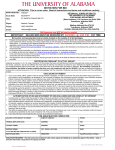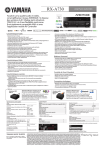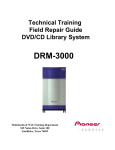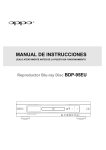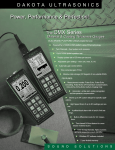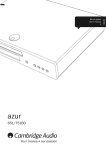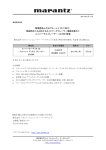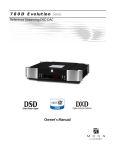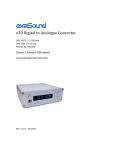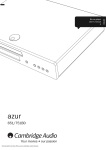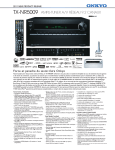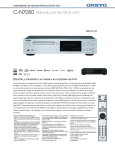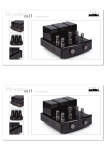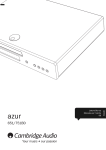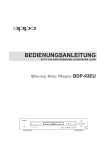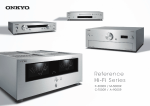Download "user manual"
Transcript
VERSUS di Franco Guida CAMBRIDGE 751BD IDENTITY CARD Company: Cambridge Model: 751BD Type: Universal Player Size (LxHxW): 430x85x312 mm Weight: 5.0 kg Main characteristics declared– compatible discs: Blu-ray (2D and 3D), DVD-Video, DVD-Audio, SACD, CD, CD-R/RW, DVD±R/RW, DVD±R DL, BD-R/RE Compatible video formats: MPEG-2, MPEG-2 HD, MPEG-4, MPEG-4 AVC, VC-1, XviD, VCD, AVCHD, MPEG ISO, AVI, VOB, MKV (4.1), JPEG, JPEG HD. THD+N: 0.001% (1 kHz) <0.003% (20 Hz-20 kHz) Intermodulation distortion: <0.0002% ( 19/20 kHz). S/N Ratio: -108 dB Crosstalk: >-100 dB (1 kHz). Total jitter: <50 pS PRICE €1,250.00 WHAT WE LIKED − High audio and video quality − Wireless connection and eSATA interface − Compatibility with all optical discs WHAT WE DID NOT LIKE − Remote control Distributed by: Hi-Fi United S.r.l., Via Manfredi 98, 29100 Piacenza. Tel. 0523 716178 MARANTZ UD7006 IDENTITY CARD Company: Marantz Model: UD7006 Type: Universal Player Size (LxHxW): 440x109x330 mm Weight: 4.8 kg Main characteristics declared – compatible discs: BD-video, DVD-Video, DVD-Audio, SACD, CD. Frequency response: BD (Linear PCM) and DVD (Linear PCM) 2 Hz-22 kHz (sf=48 kHz), 2 Hz-44 kHz (sf=96 kHz), 2 Hz-88 kHz (sf=192 kHz sampling); SACD 2 Hz-40 kHz; CD 2 Hz-20 kHz THD+N: 0.0008% (BD stereo output). Dynamic range: 110 dB (BD) S/N Ratio: 125 dB. Level/impedance of analogue outputs: 2 Vrms/10 kohm PRICE €990.00 WHAT WE LIKED − High audio quality − Compatibility with all optical discs − Price within €1,000 WHAT WE DID NOT LIKE − Flac files not compatible 26 dv Distributed by: Marantz Italy S.r.l., Via Manfredi 98, 29122 Piacenza. Tel. 0523 716899 - Fax 0523 716593 No.142 March 2012 VERSUS In choosing the rival parties for this VERSUS of 3D-compatible universal players, we decided to satisfy a need which is very common among those who own a home theatre equipped with a good multichannel amplification but lacking an updated decoding section. Actually, many of those enthusiasts, in order to enjoy hi-fi audio content, would prefer not to have to buy a new HT sinto-amplifier or, in the top quality systems, an HT amplifier or pre-decoder (which, by the way, is generally aesthetically matched to the multichannel final amplifier). The universal players tested in this VERSUS, all equipped with analogue multichannel outputs, are the most logical solution for updating a system such as the one described above, continuing to use the still good amplification section, and therefore saving money. Moreover, these players can integrate the characteristics of an outdated decoding section, playing multimedia content not stored on optical disc. To better highlight such functionalities, in this VERSUS you will find a specific section describing what each product has to offer in this regard. As far as prices are concerned, the most expensive products are Oppo and Cambridge, at around €1,200, followed by Marantz which is €200 less. Yamaha has a price range of its own, costing even less than €500. OPPO BDP-95EU IDENTITY CARD Company: Oppo Model: BDP-95 EU Type: Universal Player Size (LxHxW): 430x98x311 mm Weight: 7.3 kg Main characteristics declared – compatible discs: BD-Video, Blu-ray 3-D, DVD-Video, DVD-Audio, SACD, CD, CD-R/RW, DVD±R/RW, DVD±R DL, BD-R/RE. Frequency response: RCA 20 Hz-20 kHz ±0.2 dB, 20 Hz-96 kHz ±1.0 dB; XLR 20 Hz- 20 kHz ±0.3 dB, 20 Hz-96 kHz ±2.5 dB. Dynamic range: >110 dB THD+N: <0,0003% (1 kHz, 48 kHz/24 bit, 0 dBFS, 20 kHz LPF), <0,0017% (1 kHz, 44.1 kHz/16 bit, 0 dBFS, 20 kHz LPF). S/N Ratio: >130 dB (A weighted, automute on), >115 dB (A weighted, auto-mute off). Separation: >100 dB. Level/ impedance of analogue outputs: 2.1 Vrms (RCA 0dBFS), 4.2 Vrms (XLR, 0dBFS) PRICE €1,199.00 WHAT WE LIKED − High audio and video quality − Technical performance − Wireless connection and e-SATA interface WHAT WE DID NOT LIKE Distributed by: Labtek, Viale del Lavoro 46, Z.I. Paludi, 32010 Pieve d’Alpago (BL). Tel. 0437 370176 - Fax 0437 370177 YAMAHA BD-A1010 IDENTITY CARD Company: Yamaha Model: RX-A810 Type: Universal Player Size (LxHxW): 435x96x316 mm Weight: 4.1 kg Main characteristics declared – compatible discs: BD-Video, Blu-ray 3-D, DVD-Video, DVD-Audio, SACD, CD Frequency response: BD/DVD 2 Hz-22 kHz (sf 48 kHz), BD/DVD 2 Hz-44 kHz (sf 96 kHz), CD 2 Hz-20 kHz. Dynamic range: >105 dB (BD/DVD), >100 dB (CD) THD+N: <0,0028% (BD/DVD), <0,003% (CD) S/N Ratio: >115 dB (BD/DVD/CD). Level of analogue outputs: 2 ±0.3 V (1 kHz, 0 dB, BD/DVD/CD) PRICE €429.00 WHAT WE LIKED − Very low price − Compatibility with all optical discs WHAT WE DID NOT LIKE Distributed by: Yamaha Music Europe GmbH, Branch Italy, Viale Italia 88, 20020 Lainate (MI). Tel. 02 935771 - Fax +39 02 9370956 − AVCHD files playback No.142 March 2012 dv 27 VERSUS CAMBRIDGE From the renowned British manufacturer, this is one of the two universal players now on catalogue. It is the most valuable one, standing out for the superior quality of its D/A conversion section and the analogue output stages. Audio signals oversampling, the availability of an e-Sata interface for connecting a hard-disk, compatibility with wireless networks (without having to buy extras) and the presence of two HDMI 1.4 outputs are also very attractive features. The high quality of this player is proven by the fact that it has been chosen by EISA as best product in the universal players category. T DESCRIPTION AND FUNCTIONS 751BD he 751BD has a pretty simple and traditional design, except for a rather evident detail on the upper part. It looks like a jog knob for forwarding or rewinding playback frame by frame. The resemblance is so close that you are tempted to turn the knob, expecting it to rotate. It is actually just Cambridge’s logo, made up of a circle that contains another circle, smaller and decentralized. Available connections include first of all 2 HDMI 1.4 outputs that can prove useful when the decoding section is unable to sort video 3D signals and you therefore want to use one HDMI to directly connect the player to the 3D TV or the 3D video projector and the other HDMI connection to send digital audio signals of the Blu-ray discs HD audio encoding to the decoder. The two HDMI connections can also be used if you want to send audio 28 dv and 3D video signals at the same time to the TV and video projector. Other available connections include a component output, a video composite output, two digital audio outputs (one on optical connector, the other on coaxial), a 7.1 analogue multichannel output, an analogue stereo output and the pc terminals, namely an Ethernet terminal, two USB ports (one of which on the front panel), an E-sata terminal for hard disk and a RS-232C serial port. To connect it to the home network, the product is equipped with a pen drive that allows wireless connection. Such a possibility is really useful because – unless you are lucky enough to have the router located next to the HT system – you do not necessarily need to connect the network cable to the 751BD. The characteristics related to audio and video playback without optical discs are described in No.142 March 2012 VERSUS is not linear, does not have the pre-ringing, but the ringing following the impulse has a longer duration compared to that of linear phase filters. The remote control keys are not backlit, so it is not really comfortable to use considering the poor differentiation and small size of the keys themselves. The crown serving as arrow keys which is placed around the central circular key used to make selections is not particularly easy dv to use either. DESCRIPTION AND FUNCTIONS the specific box. Here we can just add that the great care in the creation of the audio section is also confirmed by the possibility for the user to select the digital filter to be used in the D/A conversion. More precisely, two linear phase filters are present, one of which with a high slope over the upper end of the audio band, leading to a 2 dB attenuation on that extreme (20 kHz). These two filters have a brief ringing before and after the input. The third filter, which Inside the device, mechanics and power section are masked by black glossy covers. You can easily find – it being installed on the upper part – the sound card including 5 Wolfson D/A converters and the DSP performing oversampling at 192kHz/24 bit. No.142 March 2012 dv 29 VERSUS MARANTZ From the catalogue of one of the long-standing hi-fi brands, we chose this universal player, the most reasonable of those equipped with multichannel analogue output. It is a very interesting device that can deliver high quality audio and video performance at a reasonable price. Following Marantz’s tradition, particular care has been dedicated to the audio section. T DESCRIPTION AND FUNCTIONS UD7006 hat the black finish is not – in the opinion of many, myself included – the most nice-looking has been said more than once. When speaking about this player, however, saying it once again seems natural having seen the picture of the light version, with the centre of the front panel nicely differentiated from the sides. After this concession to beauty, let’s start talking about what interests us more in this section, that is to say, the characteristics of the player. As far as digital outputs are concerned, we do not find more than is necessary, namely a HDMI 1.4 output and a digital audio output only on coaxial connector. This, however, is not a limitation when playing Blu-ray discs in the hypothetical situation we described in the beginning (good level HT system with outdated decoding section): in such a situation, in fact, the digital audio section would not be used, since it would not allow to use the HD audio encoding. Moreover, even when playing audio signals that the decoding section of the system can process and using such section (which is not totally obvious, given the reasons we will explain later on), it is almost impossible that a free digital coaxial input is not available on the system that integrates the audio decoder. The reason why this would 30 dv probably not be the case is that such a situation seems to assume a better quality of the D/A conversion section of the external decoder. If it was the case, some doubts may arise regarding the better results that could be obtained with a better encoding (HD) and a worse D/A section, compared to the results attainable with a nonHD encoding and a better D/A section. As far as analogue outputs are concerned, besides the multichannel one – which qualified the player to participate in this VERSUS – there is a dedicated stereo output. There are three pc terminals: an Ethernet port and a RS-232C port on the rear panel and a USB on the front panel, whose characteristics are listed in the specific box. However, in this section we can point out that a USB pen drive is not supplied with the device and is not available as an extra to allow a wireless connection to the home network. As a consequence, in order to make use of the networking features, an Ethernet cable must be connected to the player. The remote control is not backlit, but the keys are made of glowing material that is visible in the dark, even though what’s written on them is not easily legible. However, the difference in shape of some frequently used keys makes them instantly recognizable. dv No.142 March 2012 VERSUS DESCRIPTION AND FUNCTIONS Inside, we appreciate the noteworthy accuracy of the assembly that makes it possible to easily recognize the main sections of the device. At the centre we find the mechanics and, next to the rear panel, the graphics card, for the most part covered by the processor heat sink. On the left there is the sound card, on which the five D/A Burr-Brown PCM1795 converters are located. On the opposite side, there is the card housing the power section components. No.142 March 2012 dv 31 VERSUS OPPO This is one of today’s most appreciated digital players, thanks to the use of particularly valuable components both in the video and the audio sections, despite its still reasonable price. Besides the excellent performance that the player can deliver as far as video and sound quality are concerned, an extraordinary number of functions and a remarkable care in the assembly clearly stand out. In many ways, this player is the audiophile version of the BDP-93EU, but with some radical changes in the D/A conversion section, analogue output stages and power section. B DESCRIPTION AND FUNCTIONS BDP-95EU DP-95EU looks soberly elegant and does not stand out for any flashy or out of the ordinary characteristic. As far as connections are concerned, the situation is the same as Cambridge because their architecture, except for the audio and power sections, is basically identical. Therefore, also on this product we find the unusual presence of a second HDMI output on the rear panel, as well as an e-Sata port which can be used to connect a hard disk equipped with the same interface. Thanks to this possibility, considering the huge capacity of today’s hard disks, it is clear that the player can access vast archives of multimedia content. The most part of the remaining connections, on the other hand, can be considered standard: there is a multichannel analogue audio output (compulsory for all the players participating in this VERSUS), an unbalanced analogue stereo output, two digital audio outputs (on coaxial and optical connector), component and video composite analogue video outputs, Ethernet port, USB port and RS-232C serial port. Non-standard is the presence of a balanced 32 dv stereo analogue audio output. On the front panel, as usual, there is another USB port, to make the connection of portable devices easier. As regards connection to the home network, the resemblance to the Cambridge player becomes apparent again, with the possibility of activating a wireless connection using the USB pen drive supplied with the player. Like the Cambridge player, moreover, the pen drive slot can be chosen freely, thanks to the USB extension cable supplied with the player. As for the functions for playing contents not recorded on discs, reference should be made to the specific box. Among the other available functions, there is not, unlike with Cambrigde, the possibility of choosing different types of digital filters in the D/A audio conversion. However, like the Cambridge, images can be enlarged (in a different way for each of the two HDMI outputs, since video processors are different). The remote control is backlit and well structured, and is therefore easy to use both in the light and in the dark. dv No.142 March 2012 VERSUS DESCRIPTION AND FUNCTIONS With the USB pen drive supplied, wireless connection can be activated. Inside the BDP-95EU, we first of all notice the wide card that occupies more than half of the device’s surface. It is the card housing the audio section components performing the D/A conversion and processing the analogue signals up to the outputs. Such components are not visible since the card is turned inside out, but from the weldings we can distinguish separate components assembled with a low density, which explains the large size of the card itself. The only visible things are the toroidal transformer manufactured by Rotel, a part of the mechanics in its metal case and various electrolytic capacitors used for power voltage filtering. No.142 March 2012 dv 33 VERSUS YAMAHA Finding a 3D universal player equipped with multichannel analogue output for less than €500 may not seem easy; yet if you read Yamaha’s catalogue you will find it. Even though it is sold at a sensibly lower price compared to competitor players, this device is not very different from them as far as performance and functions are concerned, thus having a very interesting price/quality ratio. Moreover, in Yamaha’s catalogue, the BD-A1010 is the best 3D multimedia player, since the BDS-1067, which is around €600, is not 3D compatible, despite being declared 3D ready and presumably updatable. T DESCRIPTION AND FUNCTIONS BD-A1010 he player’s look has been chosen so as to match the Aventage series. In the black version, the upper part of the front panel is glossy while the lower has a satin finish. A bicolour version is available too, with the lower part of the panel light and the upper part dark. Despite the very reasonable price, the device is absolutely satisfying as far as connections are concerned. On the rear panel in fact we find, apart from the multichannel analogue audio output, analogue video outputs (composite and component), Ethernet port, USB port, HDMI output and a RS-232C serial port. Moreover, on the front panel another USB port is available, which makes the use of storage drives even more simple. Considering the reduced price, the absence of a wireless connection is obvious; however, having the chance to buy a USB pen drive would have been a good thing. Unfortunately, in the user manual such an extra is not mentioned, so – just as the Marantz- the only option available to make use of 34 dv the networking functions is to connect the player to the Ethernet cable from the router. For networking functions and those referring to playback of multimedia content not stored on optical discs, please refer to the specific box. On Yamaha’s website as well as in the catalogue, an I-phone compatibility is mentioned together with a future compatibility with Android devices, yet the user manual makes no reference to such a possibility. In the case of HT (sinto)amplifiers, applications which can be installed on iPhone or Android devices are often made available, allowing to control the system using a mobile phone as a remote control equipped with a touch screen. As regards the remote control supplied we can say that, as you may expect on a very cheap product, it is not backlit nor equipped with glowing keys. Usage in the dark is however possible thanks to the logical collocation and shape of the most frequently used keys that make them easily recognizable to the touch. dv No.142 March 2012 VERSUS DESCRIPTION AND FUNCTIONS Inside we can see in the central part, between the mechanics and the rear panel, the card for analogue audio and video outputs, on the left hand side the power card and on the opposite side the main card which houses the digital audio and video components and the control section. On the latter section, the finned heat sink is visible, installed with metal supports directly welded to the printed circuit board, masking the video processor. No.142 March 2012 dv 35 VERSUS THE DEEPENING CAMBRIDGE O ppo players have been shown to be excellent devices by testing, in this VERSUS, the BDP-95EU. With the same underlying architecture, Oppo’s catalogue also has a previous version – BDP-93EU – that basically differs for the lower quality of the D/A conversion section. This product, for the outstanding performances of its video section and the wide range of operational possibilities, is an ideal basis for developing high quality audio sections. By way of example, we recently came across the great Primare BD-32, a device that costs more than €3,000 and has been designed to deliver excellent performances in stereo mode. The two main front channels have been privileged both by using a stereo D/A converter specific for such channels, and by carefully creating the analogue output stages, equipped with balanced outputs. With the 751BD, Cambridge decided to engage in a similar undertaking, but choosing a different setting to Primare. In this case, indeed, all the channels have been “treated” in the same way improving their quality level compared to BDP-93EU. It is therefore a setting that favours the use of the device for playing multichannel content, unlike the BD-32 that openly sells itself as a possible replacement for a good twochannel CD or SACD player. Clearly, the fact that this Cambridge is half the price of the Primare has entailed a degree of sacrifice. In the power section, as a matter of fact, no enhancements have been made and less care has been devoted to the analogue output stages compared to the Swedish product, as highlighted by the absence of balanced outputs too. But let’s go back to the D/A conversion section by adding that, in lieu of the still good integrated multichannel 36 dv 751BD Cirrus Logic CS4382A converter which equips Oppo BDP-93EU, Cambridge designers used 5 excellent Wolfson WM8740S suitable for stereo usage. Moreover, they chose to oversample the signal to be converted at 192 kz/24 bit using an Analog Devices ADSP-21261 processor which processes the technology for oversampling and jitter reduction – named Q5 – developed by Anagram Technologies. Unfortunately, Cambridge decided to keep oversampling always on, without offering the user the option of choosing whether to use it or not. We gave priority to audio, since it has been treated with particular care in this device, but as mentioned before the video section is excellent as well. As a matter of fact, on the primary HDMI output, the valuable Marvell DE2750 video processor, using Qdeo technology, has been used. Such a technology, apart from performing scaling and interlacing operations with efficient algorithms, can even improve images as far as video noise, contrast and colour are concerned. As regards the second HDMI output, Oppo’s OP8531 video processor is used, less advanced than Marvel’s. As video decoder, Mediatek MTK8530 is used, which was the first to allow playback of DivX Plus HD format based on the H.264 standard. To conclude, just a reference to the glossy black plastic sheets covering mechanics and power section, on which it is declared that those two sections have been designed by Cambridge. Since apparently they are identical to Oppo BDP-93EU’s, we can assume, without any evidence of mergers or acquisitions between the two brands, that Cambridge designers introduced some changes not noticeable with a simple overall visual inspection. dv in pillole AN EXCELLENT PLAYER which can combine a great basic project with a particularly accurate audio section. On the lower part of the rear panel, we find pc, digital and analogue video terminals. On the upper right there are the 7.1 multichannel analogue audio and stereo terminals. No.142 March 2012 R in pillole A DEVICE THAT CAN deliver very interesting audio and video performance in its category. eading the video processor’s name was not possible, as it is covered by a wide metal plate that functions as heat sink, aided by a finned element pressure fitted onto the plate. Instead, the D/A conversion section and the analogue output stages can be easily examined, so we can provide some information on the main components used. Marantz’s choice, as far as D/A converters are concerned, fell on Burr-Brown, one of the most appreciated brands in the industry. The choice did not fall – as normally happens in cheaper devices – on just one integrated multichannel converter, but on five two-channel devices designed to be used on stereo systems. They are PCM1795 that can also process 32 bit audio signals adopting the well-known Advanced Segment conversion technology developed by BurrBrown. Nominal performance of such converters is excellent, as shown by dynamic range (123 dB), THD+N (0.0005%), S/N ratio (123 dB) and separation (119 dB) values. The digital filter is without question good too, performing a 8x oversampling and capable of 98 dB stop-band attenuation and keeping the pass-band ripple within 0.0002 dB. The converter also offers the chance to choose between two different slopes of the digital filter, even though this possibility has not been transferred to the D7006 user. After the converters, as for outputs, we find analogue stages where a large use of 4565D dual operational amplifiers has been made. Of course, for price reasons this model could not use in the analogue output stages the excellent HDAM modules (Hyper Dynamic Amplifier Module) that Marantz has been using for almost 20 years in its top products, and that stand out for their high speed and extended bandwidth. Power supply, as it generally is these days on optical discs players, is switching type. VERSUS UD7006 dv Scheme of the D/A Burr-Brown PCM1795 converter On the rear panel, analogue multichannel and stereo outputs are on the lower right. In the lower central part we find the Ethernet port, HDMI output, digital audio output on coaxial connector and video analogue outputs in component and video composite formats. No.142 March 2012 dv 37 THE DEEPENING MARANTZ VERSUS OPPO THE DEEPENING A BDP-95EU s we have little room, we ought to focus on the characteristics of the audio and power sections to describe BDP-95EU design, given that for the video section the same positive considerations made for the Cambridge apply to this product too. Starting from the audio section, we can first of all say that this player integrates two pieces of one of today’s most famous converters, ESS’s most valued model. It is the ESS ES9018S, which is at the top of Sabre32 Reference series and makes use of the most sophisticated solutions patented by ESS, such as the 32 bit Hyperstream technology and Time Domain Jitter Eliminator. The ES9018S functions both in multichannel (8 channels available) and stereo mode. Even in stereo mode, however, all the converters for the 8 channels are used, connecting their outputs in parallel in groups of four so as to obtain the two stereo channels. This explains the reason why two pieces of ES9018S are used: one for the 7.1 ch multichannel output, the other for the balanced and unbalanced stereo outputs. Parallelization of D/A converters outputs when the ES9018S is used in stereo mode markedly improves performance (especially dynamic range) compared to the use of just one converter per channel. For example, in the case of the ES9018S, dynamic range goes from 129 dB in 8 channel mode to 133 dB in stereo mode. As regards the other characteristics of this excellent player, we can mention the use of the 6 bit 38 dv Hyperstream modulator (which the name of the conversion architecture comes from) presenting various original aspects if compared to the widely diffused delta-sigma modulations available on the market. Each one of the 8 channels uses a couple of 6 bit converters that operate anti-phase, so there are 16 converters for each ES9018S. As far as Time Domain Jitter Eliminator is concerned, we can say that – by means of sophisticated techniques based on operations performed in the time domain (for example the use of digital delay lines) – traditional techniques of clock recovery can be avoided, reducing jitter extremely well. Having said that about the two Sabre, we can also add that analogue output stages are made of separate components using a wide surface for the assembly, as proven by the size of the card on which they are located. As already mentioned, the other section that has been noticeably modified compared to the BDP-93EU is the power section. In particular, in the audio section, a specific power section has been added that makes use, among other components, of a really good toroidal transformer by Rotel. in pillole VERY VALUABLE COMPONENTS, excellent performance at a reasonable price: it is clearly a device that must be held in high esteem. dv One of the two ESS Sabre ES9018S converters used in the BDP-95EU On the rear panel, analogue multichannel and stereo outputs are on the lower right. In the lower central part we find the Ethernet port, HDMI output, digital audio output on coaxial connector and video analogue outputs in component and video composite formats. No.142 March 2012 W in pillole It does not deliver the same performance as the other three rivals; yet, for a little more than 400 euros, demanding more would be unjustified. On the rear panel, analogue video and audio connections and digital audio connections are grouped together in the central part; Ethernet port, USB port and HDMI output are separate and located on the left. No.142 March 2012 VERSUS BD-A1010 e were not able to determine what video processor had been used for the BD -A1010 either, since it is covered by a heat sink that is not easy to remove. The system covered by the sink, besides performing deinterlacing and scaling operations, probably performs most of the remaining functions (video and audio decoding, D/A conversion of video and audio signals, mechanics control, etc.), unless other components are hidden under the sink. Therefore, on the card, the only significant device visible is the one performing the audio D/A conversion of two channels only (probably those related to stereo output). It is a converter manufactured by Wolfson, the British manufacturer particularly regarded for this type of components. More precisely, it is the WM8524 converter, which of course is not one of Wolfson’s top products, yet delivers a rather good performance. The dynamic range is 104 dB and signal to noise ratio has the same value (not weighted) and is 106 dB (weighted). Total harmonic distortion is 89 dB attenuated and channel separation equals 100 dB at 1 kHz and 95 dB for the entire audio range. As regards digital filter performance, the passband ripple is 0.1 dB and stop-band attenuation reaches 50 dB. The reading mechanics is not closed up in a metal case: it is the BD412VLY, manufactured by AAI. The power section is switching type and on the card hosting it there is also a fan discharging hot air through the rear panel. In the card that the analogue video and audio connectors are located on, there are a lot of separate components, mostly electrolytic or polyester capacitors. dv THE DEEPENING YAMAHA Scheme of the Wolfson WM8524 D/A Converter. dv 39 PERFORMANCE MEASURED IN OUR LABORATORY Blu-ray player Cambridge Audio Azur 7518D Blu-ray player Marantz U7006 PCM MODE 96 kHz/24 bit for all tests – filter no.1 Output level Left 2.08V, right 2.08V (1 kHz/0dB): Output 639 ohm impedance: Practically perfect level and balancing of channels; Weight: 1 limited output impedance. PCM MODE 96 kHz/24 bit for all tests Output level Left 2.03V, right 2.06V (1 kHz/0dB): Output 209 ohm impedance: Correct level; almost perfect balancing, low output Weight: 1 impedance. Dynamic range: Left 107.1 dB, right 108.5 dB Actual resolution: Left >17.2 bit, right >17.1 bit Dynamic range: Left 109.3 dB, right 109.1 dB Actual resolution: Left >17.6 bit, right >17.6 bit 9 Weight: 1 State-of-the-art values are even higher than these are; however, there are not many integrated players like this one. 9 9 Frequency response with 96 kHz sampling is extended (-0.6 dB at 40 kHz), with very limited ripple. Weight: 2 Harmonic distortion at low levels (signal 1 kHz/ -70.3 dB). Response unusually rising at the acute end, but by a small dB fraction; insignificant ripple. Harmonic distortion at low levels (signal 1 kHz/ -70.3 dB). 8 Weight: 3 9 Some distortion at the minimum levels exists, but rather limited in absolute terms. Leftovers in pass-band and stop-band (spectrum of a 16 tone signal between 40500 and 47531.25 Hz, peak -3 dB. Signal in blue) Weight: 2 Weight: 3 Excellent linearity at low levels, moderate noise and spurious emissions. Leftovers in pass-band and stop-band (spectrum of a 16 tone signal between 40500 and 47531.25 Hz, peak -3 dB. Signal in blue) 9 Powerful filtering, few and weak images and no reflection in audio band. Weight: 2 9 Irreprehensible: images rapidly bending, weak back reflections and none in audio band. Jitter test (spectrum of a pure tone 24 kHz/-6dB) 8 Very low periodic jitter, even though distributed on many micro-components; random jitter is a lot higher but still limited in absolute terms. 7 FFINAL SCORE Jitter test (spectrum of a pure tone 24 kHz/-6dB) Weight: 2 10 Frequency response (at -3 dB) Frequency response (at -3 dB) Weight: 2 9 8.5 Weight: 2 Comparable periodic and random jitter, limited in absolute terms. FFINAL SCORE Weight: 1 Actual resolution is high and not far off the value obtainable by the dynamic range, proof that the device creates very weak modulation spurious emissions. 9 8.5 PERFORMANCE MEASURED IN OUR LABORATORY Blu-ray player Oppo BDP-95 EU Blu-ray player Yamaha BD-A1010 PCM MODE 96 kHz/24 bit for all tests; balanced outputs tested Left 4.25V, right 4.27V Output level (1 kHz/0dB): Output 201 ohm impedance: Practically perfect level and balancing of channels, Weight: 1 low output impedance. Levels and impedance of unbalanced outputs are reduced by half. Dynamic range: Left 121.9 dB, right 121.9 dB Actual resolution: Left >17.8 bit, right >17.8 bit PCM MODE 96 kHz/24 bit for all tests Left 2.08V, right 2.08V Output level (1 kHz/0dB): Output 642 ohm impedance: Practically perfect level and balancing of channels, Weight: 1 moderate output impedance. Sometimes it’s a pity not to be able to give more than ten… 10 Frequency response (at -3 dB) Dynamic range: Left 106.9 dB, right 106.3 dB Actual resolution: Left >16.3 bit, right >16.3 bit Weight: 1 8 Good dynamic range and fairly good actual resolution. Frequency response (at -3 dB) 9 Weight: 2 9 -0.4 dB at 41 kHz with 96 kHz sampling and almost no ripple. Not bad at all! Weight: 2 Harmonic distortion at low levels (signal 1 kHz/ -70.3 dB). Extended response (-0.4 dB at 40 kHz) and limited ripple. Harmonic distortion at low levels (signal 1 kHz/ -70.3 dB). 9 10 Weight: 3 Great! Please note that the base of the graph has been extended to -160 dB, otherwise noise would have been below the base. Leftovers in pass-band and stop-band (spectrum of a 16 tone signal between 40500 and 47531.25 Hz, peak -3 dB. Signal in blue) Weight: 2 Weight: 3 Observable spurious emissions, yet microscopic. Leftovers in pass-band and stop-band (spectrum of a 16 tone signal between 40500 and 47531.25 Hz, peak -3 dB. Signal in blue) 9 Great performance, also as regards elimination of spurious emissions. Jitter test (spectrum of a pure tone 24 kHz/-6dB) Weight: 2 10 9 Good in both ultrasonic and audio band. Jitter test (spectrum of a pure tone 24 kHz/-6dB) 8 FFINAL SCORE Weight: 2 9 Periodic jitter around a picosecond (light covers 0.3 mm in that time!), random jitter around 78 picoseconds. Among the best values measured so far. 9.6 Weight: 2 Reduced jitter, even though very much composite. FFINAL SCORE Weight: 1 10 8.7 VERSUS MULTIMEDIA READING WITHOUT DISC COMPARED T made a good title: in fact, it would have excluded playback from external drives (pen drives and hard disks) directly connected to the device typically through USB or e-SATA interfaces. So let’s start from this very functionality by saying that the four players are all equipped with USB interface, while just two of them namely Cambridge and Oppo – have e-Sata interface as well. As the readers (and this time I am speaking about people and not devices!) of the magazine AudioREVIEW know perfectly well, having seen a lot of tests involving the so-called USB DACs (D/A converters equipped with USB port), the use of this type of interface can imply some limitations regarding sampling frequency and sample size of the digital audio signal, as well as the encoding type used for the signal (which then influences the type of compatible files, such as mp3, flac…). Similar (sometimes not identical) limitations can arise when reading from network interfaces, both Ethernet and wireless. Going back to USB interface, from the point of view of the performance, the type THE PLAYING he title of this section may appear a little on the long side, but I was not able to find a shorter version that suited it perfectly. As a matter of fact, if with “multimedia content” we mean – as usual – recordings of sounds, fixed and moving images (at least in the HT context, the one we are interested in), it would certainly be confusing for multimedia reader to be understood by a player capable of playing not different types of content, but from different types of archives: optical discs or external memories directly connected to the device or to servers on local or remote networks connected to the Internet (actually, to this we must add streaming playback of nonrecorded audio and video content, that is to say live, from digital radios and TVs available online). So I was inclined to give up on a simple title such as “multimedia reading compared”, resolving to use the more complex one that you see above. One last note before proceeding with the comparison, let’s add that not even the often used expression “network functionalities” would have 42 dv No.142 March 2012 VERSUS 32-192 kbps) and wav (44.1 kHz/16 bit). As regards moving images, on all machines every file containing the encoding specified for the video DVD and Blu-ray standards can be played, that is to say, MPEG-2 and MPEG-4 AVC (H.264), as well as the versions derived from the latter (DivX and AVHCD). As regards fixed images, obviously all the players can read jpeg files. What has been said so far regarding USB also applies when files to be played are on DLNA server of the local network or on the Internet. In the latter case, specific services (free or not) can be associated, accessible through a browser and plug-ins in the case of a pc, or through software contained in the firmware of the machines, in the case of these players. Thanks to these applications, you can enjoy Picasa on Cambridge, Youtube on Marantz and Yamaha, both Picasa and Youtube on Oppo. It must be said, however, that in the versions of such players intended for markets such as the US one, various other services can be enjoyed, such as buying or renting movies online. For example, the US version of Oppo allows use of Netflix, Blockbuster, Vudu, Film Fresh. We can even observe that, unlike what normally happens for sinto amplifiers, in those four players the possibility of listening to digital radios on the internet has not been provided for. dv THE PLAYING of solution adopted to reduce jitter can make the difference (for example the synchronous data transmission on this type of interface instead of asynchronous), but we do not have enough space or data to engage in such a comparison. Therefore, let’s just say that regarding audio playback from USB interface, in Cambridge’s user manual no limitations in sampling frequency and size of samples are mentioned. As regards the type of files that can be played, the manual says they are mp3 and wma only. Actually, from the tests emerged a positive surprise, in that the device can also play high definition audio flac files without any limitations on sampling frequency, that can then reach a maximum of 192 kHz (24 bit sample size). Moving on to Marantz, it is declared that audio content encoded in mpeg1 audio player 3 (mp3 file, 32-48 kHz sampling frequency and 64-320 kbps bitrate), in mpeg4 aac (m4a file, 32-48 kHz, 16-320 kbps), in wma (wma file, 32-48 kHz, 48-192 kbps) and in lpcm (wav file, 44.1 and 48 kHz, 16 bit) can be played. As regards Oppo, the user manual does not say anything about the type of files and sampling frequencies, so it was the test that provided us with the information. The situation, as it could be guessed given the resemblance between the two machines, was the same as that of Cambridge. To conclude, for the Yamaha it is declared that it can play mp3 files (32-48 kHz, 8-320 kbps), wma (32-48 kHz, No.142 March 2012 dv 43 VERSUS VIDEO AND AUDIO COMPARED VIDEO AND AUDIO COMPARED T he first phase of the testing focused on evaluating the video quality delivered by the four players. To begin with, various Blu-ray discs were played, some of which in 3D version. In this situation, all the devices performed at least well, and brilliantly in the case of Cambridge and Oppo. These two players, indeed, stood out for their ability to improve the details of the images, making them even more contrasted and neat (that is to say, less affected by video noise). These characteristics are nearly always perceived as an improvement, yet sometimes can give a slight impression of artifice. Then, various DVDs were played, this time delivering much heterogeneous results. In fact, while with Marantz and especially with Yamaha, the image resolution appears very far from that of Blu-ray, with Cambridge and Oppo the gap – even though there still is one! – tends to be reduced a little. With Cambridge and Oppo, moreover, moving images appear to be better, with fewer artifacts. As regards artifacts, we must point out that in a specific situation – playback of AVCHD file recorded with a HD camera and transferred on a USB pen drive – Yamaha generated an intolerable number of them. Let’s now move on to audio performance, which has been tested almost exclusively using the multichannel CAMBRIDGE 751BD COMMENT Performance High audio and video quality Operating options Universal player, analogue multichannel output, wireless connection, eSATA port, flac files playback, double HDMI output. Manufacturing Very good video processor, good overall level. Price/quality ratio Very high. Measures Reasonably high level. analogue output and by playing Blu-ray discs. With the three more expensive players, results proved that they can be a valid or even better alternative to a good medium-end sinto amplifier. With Yamaha, the quality of the performance was not the same, yet still good if we consider its low price. To better verify the sonic quality with high definition audio, in the last part of the session excellent quality stereo recordings were played, both on CD, SACD and USB pen drive (in the latter case, high definition flac files were played on Cambridge and Oppo, capable of reading them). In this situation, as far as audio definition is concerned, Oppo seems to prevail a little on Cambridge, Cambridge seems slightly better than Marantz, while Yamaha still follows behind. In some cases, however, Cambridge and Marantz seemed to have a touch of spontaneity that Oppo lacks. As regards sonic image focusing, Oppo performed better even though sometimes Marantz and Cambridge seemed to be able to better recreate its amplitude. Yamaha is the less convincing in this case too, but the gap is not so big. To conclude, in flac files playback, both Cambridge and Oppo deliver very good performance, confirming the same slight differences between the two measured with regard to optical disc playing. dv OPPO BDP-95 EU SCORE Performance Good video performance, high audio quality. Operating options Universal player, analogue multichannel output, playback from USB and network. Manufacturing Good overall. 44 SCORE High audio and video quality. 9 8.5 Performance 9.5 Operating options 10 Price/quality ratio Unlikely to be equaled. Measures Simply outstanding. 9 9.5 9.6 8.5 9 8.5 Universal player, analogue multichannel output, wireless connection, eSATA port, flac files playback, double HDMI output, balanced stereo output. Very good video processor, excellent audio Manufacturing converters, accurate power section. MARANTZ UD7006 COMMENT COMMENT YAMAHA BD-A1010 COMMENT SCORE 8 8.5 8 SCORE Performance Outstanding, considering its reduced price. 7.5 Operating options Universal player, analogue multichannel output, playback from USB and network. 8.5 Manufacturing Satisfactory components, considering the device class. 7.5 9 Price/quality ratio Not comparable to Oppo and Cambridge (which, however, cost 20% more). 8.5 Price/quality ratio Not easy to find a universal player with this price. Measures Overall performance of a very high level. 8.7 Measures Very good overall performance. 8.7




















